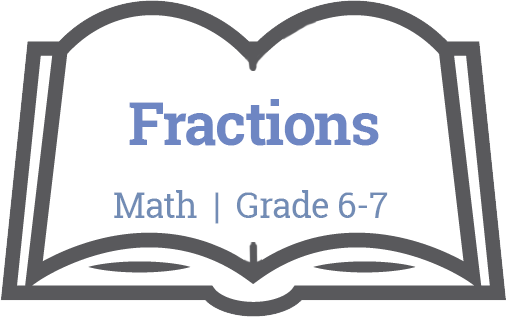
Unit Plan: Fractions
Math / Grade 6-7

Big Ideas
- Mixed numbers and decimal numbers represent quantities that can be decomposed into parts and wholes. (Grade 6)
- Decimals, fractions, and percents are used to represent and describe parts and wholes of numbers. (Grade 7)
Concepts:
- Relationships
- Quantity
- Space
Essential Questions
Students will keep considering…
- How do fractions show relationships?
Evaluative Criteria
- Quizzes of specific skills
- Diamond papers linked to curricular competencies (see learning plan)
- Unit test with computation based questions (i.e. making equivalent fractions, converting between mixed numbers and improper fractions, comparing and ordering)
Monitoring Progress
Teacher will monitor progress:
Teachers can monitor progress through ongoing formative assessment including but not limited to:
- Check ins
- Teacher observation
- Homework
Resources
ONLINE RESOURCES
Reflection
How will teachers and their students reflect on and evaluate the completed project?
Teacher Reflection
- What aspects of the unit went well?
- What did students struggle with?
- What did you struggle with?
- What would you add/revise the next time you taught this unit?
- Were there any unintended outcomes?
- Were students engaged?
Downloads
Stage 1 – Desired Results
Big Ideas
- Mixed numbers and decimal numbers represent quantities that can be decomposed into parts and wholes. (Grade 6)
- Decimals, fractions, and percents are used to represent and describe parts and wholes of numbers. (Grade 7).
Concepts:
- Relationships
- Quantity
- Space
Transfer Goals
Students will be able to independently use their learning to…
- Recognize relationships in other contexts.
Meaning
Students will understand that…
- Fractions show parts and wholes.
- Fractions represent a quantity.
- Equivalent fractions take up the same amount of space.
- Fractions show relationships.
Students will keep considering…
- How do fractions show relationships?
Acquisition
Students will be skilled at…
REASONING & ANALYZING
- Use reasoning and logic to explore, analyze, and apply mathematical ideas
- Demonstrate and apply mental math strategies
- Model mathematics in contextualized experiences
UNDERSTANDING & SOLVING
- Apply multiple strategies to solve problems in both abstract and contextualized situations
- Visualize to explore mathematical concepts
COMMUNICATING & REPRESENTING
- Use mathematical vocabulary and language to contribute to mathematical discussions
- Explain and justify mathematical ideas and decisions
- Represent mathematical ideas in concrete, pictorial, and symbolic forms
CONNECTING & REFLECTING
- Connect mathematical concepts to each other and to other areas and personal interests
Students will know…
- Improper fractions and mixed numbers
- Multiplication and division facts to 100
- Increasing and decreasing patterns
- Factors and multiples (greatest common factor and least common multiple)
Which Core Competencies will be integrated into the unit?
Positive Personal & Cultural Identity
- Self-determination
- Well being
- Solving problems in peaceful ways
- Building relationships
- Contributing to community and caring for the environment
Communication
- Connect and engage with others (to share and develop ideas)
Critical Thinking
- Develop and design
- Question and investigate
- Analyze and critiquenalyze and critique
- Generating ideas
- Developing ideas
First People's Principles of Learning

The following resources are made available through the British Columbia Ministry of Education. For more information, please visit BC’s New Curriculum.
Big Ideas
The Big Ideas consist of generalizations and principles and the key concepts important in an area of learning. The Big Ideas represent what students will understand at the completion of the curriculum for their grade. They are intended to endure beyond a single grade and contribute to future understanding.
Core Competencies
 Communications Competency
Communications Competency
The set of abilities that students use to impart and exchange information, experiences and ideas, to explore the world around them, and to understand and effectively engage in the use of digital media
 Thinking Competency
Thinking Competency
The knowledge, skills and processes we associate with intellectual development
 Social Competency
Social Competency
The set of abilities that relate to students’ identity in the world, both as individuals and as members of their community and society
Curricular Competencies & Content
Curricular Competencies are the skills, strategies, and processes that students develop over time. They reflect the “Do” in the Know-Do-Understand model of curriculum. The Curricular Competencies are built on the thinking, communicating, and personal and social competencies relevant to disciplines that make up an area of learning.
Additional Resources
First People's Principles of Learning
To read more about First People’s Principles of Learning, please click here.
For classroom resources, please visit the First Nations Education Steering Committee.
